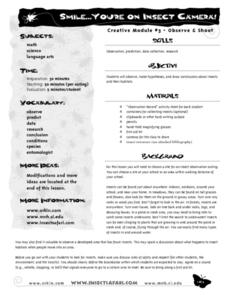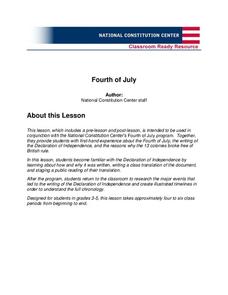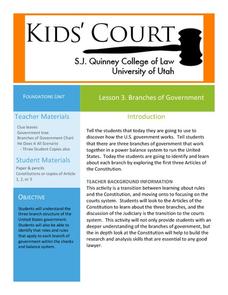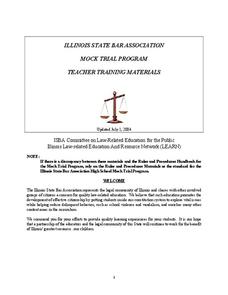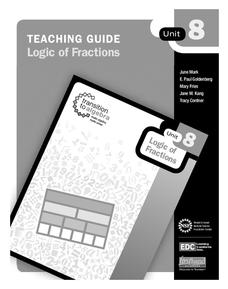Curated OER
Introduction to Fractals: Infinity, Self-Similarity and Recursion.
This lesson introduces learners to the ideas involved in understanding fractals. They develop a sense of infinity, self-similarity and recursion and
Curated OER
From Basketball Court to Supreme Court
Students discuss scenarios about unfairness and retaliation in school sports. They read about a recent Supreme Court ruling about Title IX, and research, conduct polls and write articles about public opinions on gender issues in sports.
Alabama Learning Exchange
Animal Classification
Present information about the classification of animals. After participating in the teacher-led discussion about scientific names, small groups devise their own way of classifying everyday objects present in the classroom, developing...
Curated OER
A Simulated Journey
Fifth graders experience simulations in order to meet the required Social Studies standards. In this simulation lesson, 5th graders experience a teacher set-up simulation of students being put in the Responsible Thinking Classroom for no...
Curated OER
Dictator For a Day
Students discuss dictatorship. In this Social Studies instructional activity, students review Julius Caeser's rule over Ancient Rome and they elect one student to be dictator for the day. They write about the pros and cons of having a...
Curated OER
Introduction to Sexism
Students develop an understanding of sexism, its effects, and the ways in which messages in society (in media, texts, schools, families, et cetera) reinforce stereotypical beliefs.
Curated OER
E-tiquette
Students develop appropriate ways to communicate via e-mail. They evaluate examples of inappropriate e-mails and create preferable alternatives.
Curated OER
To Kill a Mockingbird Debate
Eighth graders debate issues in the novel To Kill a Mockingbird. In this debate lesson, 8th graders break into three groups and given a view to research and debate. Students must find text to support their ideas and others' ideas.
Curated OER
Signs in the Stitching
Students exercise their creativity by designing an original quilt and a written explanation of its meaning. They use primary sources to develop an understanding of Underground Railroad routes through Indiana.
Curated OER
Smile...you're on Insect Camera!
Students study insects. They go on an outdoor insect outing and look for insects in a variety of places--in the air, under rocks, on leaves, in water, etc. They record information about the insects they find, including habitat, weather...
Curated OER
Look At Those Leaves!
Students collect, observe, sort, and measure leaves. In this leaf lesson, students take a walk to collect leaves. They bring the leaves back into the classroom to observe, sort, and measure them. They visit a website to learn more about...
Curated OER
The Branches of Government
After reviewing and reading about the three branches of US Government, complete this activity with your class. In groups, they will place their "cards" on the board under the correct branch. This lesson is weak and unclear. I'd make a...
Curated OER
Taking a Closer Look at Religions Around the World
Students explore diversity. In this religious studies lesson, students develop their knowledge and understanding of world religions as they use Internet and print sources to research Judaism, Christianity, Islam, Hinduism, Sikhism and...
Curated OER
Keep It Academic
Students study various methods to learn about religion in the classroom. In this religion study lesson plan, students read and visit links to learn about various ways of teaching religion in schools. Students learn the model world...
Curated OER
Minorities Ruled
Students investigate various European political parties with anti-immigration agendas. They examine and write written reports concerning the party goals of exclusion or restriction of immigrants in their societies. Students present...
National Constitution Center
Fourth of July (Grades 3-5)
Bring history to life for your young scholars with a Fourth of July lesson series. After a class reading of the Declaration of Independence, students translate this pivotal document into layman's terms before working in small groups to...
Discovery Education
Fuss About Dust
Dust is everywhere around us; it's unavoidable. But what exactly is dust and are certain locations dustier than others? These are the questions students try to answer in an interesting scientific investigation. Working independently or...
Curated OER
Lesson 3: Branches of Government
Young historians climb through the three branches of the US government in the third lesson of this five-part series. While reading the first three Articles of the Constitution in small groups, children write facts on paper leaves that...
Illinois State Bar Association
Mock Trial Teacher Training
Whether you are new to the mock trial format or have extensive experience with the program, you'll find much to learn from this teacher training manual that includes strategies for teaching the various aspects of court room trials.
Education World
Every Day Edit - President John Adams
In this everyday editing activity, students correct grammatical mistakes in a short paragraph about President John Adams. The errors range from capitalization, punctuation, grammar, and spelling.
Technical Sketching
Introduction — Surfaces and Edges
How different can 3-D and 2-D really be? An engineering resource provides an explanation about the importance of two-dimensional technical drawings. Several samples show how to create multi-view drawings from pictorials and vice-versa....
Education Development Center
Logic of Fractions
Before diving into operations with fractions, learners discover the foundation of fractions and how they interact with one another. Exactly as the title says, logic of fractions is the main goal of a resource that shows pupils how...
Novelinks
Wildwood Dancing: Questions using Bloom’s Taxonomy of Thinking Process
Readers respond to a series of questions focused onJuliet Marillier's young adult novel Wildwood Dancing, and crafted to reflect the levels in Bloom's Taxonomy.
EngageNY
Multiplying and Dividing Rational Expressions
Five out of four people have trouble with fractions! After comparing simplifying fractions to simplifying rational expressions, pupils use the same principles to multiply and divide rational expressions.











